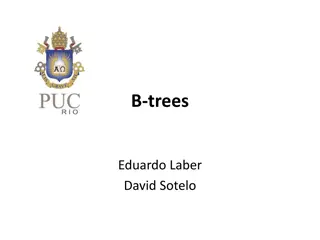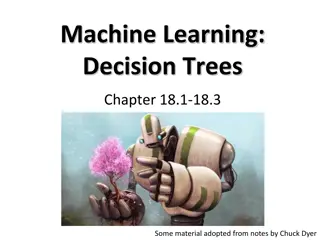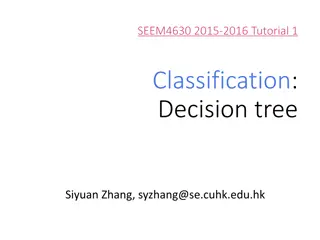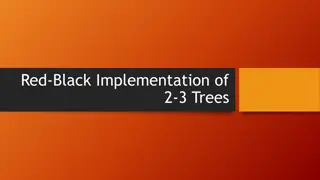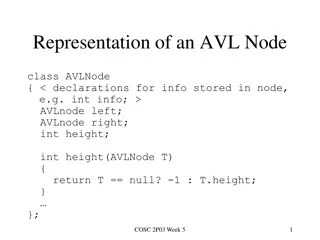Understanding Decision Trees in Machine Learning
This resource delves into the application of decision trees in Machine Learning using AIMA and WEKA. It covers datasets from UCI, like the Zoo dataset, and provides examples of using decision tree learners to predict outcomes based on various attributes. The content also includes Python code snippets for implementing decision tree learning, making it a valuable resource for those interested in mastering this fundamental ML concept.
Download Presentation

Please find below an Image/Link to download the presentation.
The content on the website is provided AS IS for your information and personal use only. It may not be sold, licensed, or shared on other websites without obtaining consent from the author. Download presentation by click this link. If you encounter any issues during the download, it is possible that the publisher has removed the file from their server.
E N D
Presentation Transcript
Machine Learning: Decision Trees in AIMA and WEKA
http://archive.ics.uci.edu/ml Est. 1987! 370 data sets
animal name: string hair: Boolean feathers: Boolean eggs: Boolean milk: Boolean airborne: Boolean aquatic: Boolean predator: Boolean toothed: Boolean backbone: Boolean breathes: Boolean venomous: Boolean fins: Boolean legs: {0,2,4,5,6,8} tail: Boolean domestic: Boolean catsize: Boolean type: {mammal, fish, bird, shellfish, insect, reptile, amphibian} Zoo data 101 examples aardvark,1,0,0,1,0,0,1,1,1,1,0,0,4,0,0,1,mammal antelope,1,0,0,1,0,0,0,1,1,1,0,0,4,1,0,1,mammal bass,0,0,1,0,0,1,1,1,1,0,0,1,0,1,0,0,fish bear,1,0,0,1,0,0,1,1,1,1,0,0,4,0,0,1,mammal boar,1,0,0,1,0,0,1,1,1,1,0,0,4,1,0,1,mammal buffalo,1,0,0,1,0,0,0,1,1,1,0,0,4,1,0,1,mammal calf,1,0,0,1,0,0,0,1,1,1,0,0,4,1,1,1,mammal carp,0,0,1,0,0,1,0,1,1,0,0,1,0,1,1,0,fish catfish,0,0,1,0,0,1,1,1,1,0,0,1,0,1,0,0,fish cavy,1,0,0,1,0,0,0,1,1,1,0,0,4,0,1,0,mammal cheetah,1,0,0,1,0,0,1,1,1,1,0,0,4,1,0,1,mammal chicken,0,1,1,0,1,0,0,0,1,1,0,0,2,1,1,0,bird chub,0,0,1,0,0,1,1,1,1,0,0,1,0,1,0,0,fish clam,0,0,1,0,0,0,1,0,0,0,0,0,0,0,0,0,shellfish crab,0,0,1,0,0,1,1,0,0,0,0,0,4,0,0,0,shellfish
Zoo example aima-python> python >>> from learning import * >>> zoo <DataSet(zoo): 101 examples, 18 attributes> >>> dt = DecisionTreeLearner() >>> dt.train(zoo) >>> dt.predict(['shark',0,0,1,0,0,1,1,1,1,0,0,1,0,1,0,0]) #eggs=1 'fish' >>> dt.predict(['shark',0,0,0,0,0,1,1,1,1,0,0,1,0,1,0,0]) #eggs=0 'mammal
Zoo example >> dt.dt DecisionTree(13, 'legs', {0: DecisionTree(12, 'fins', {0: DecisionTree(8, 'toothed', {0: 'shellfish', 1: 'reptile'}), 1: DecisionTree(3, 'eggs', {0: 'mammal', 1: 'fish'})}), 2: DecisionTree(1, 'hair', {0: 'bird', 1: 'mammal'}), 4: DecisionTree(1, 'hair', {0: DecisionTree(6, 'aquatic', {0: 'reptile', 1: DecisionTree(8, 'toothed', {0: 'shellfish', 1: 'amphibian'})}), 1: 'mammal'}), 5: 'shellfish', 6: DecisionTree(6, 'aquatic', {0: 'insect', 1: 'shellfish'}), 8: 'shellfish'})
>>> dt.dt.display() Test legs legs = 0 ==> Test fins fins = 0 ==> Test toothed toothed = 0 ==> RESULT = shellfish toothed = 1 ==> RESULT = reptile fins = 1 ==> Test eggs eggs = 0 ==> RESULT = mammal eggs = 1 ==> RESULT = fish legs = 2 ==> Test hair hair = 0 ==> RESULT = bird hair = 1 ==> RESULT = mammal legs = 4 ==> Test hair hair = 0 ==> Test aquatic aquatic = 0 ==> RESULT = reptile aquatic = 1 ==> Test toothed toothed = 0 ==> RESULT = shellfish toothed = 1 ==> RESULT = amphibian hair = 1 ==> RESULT = mammal legs = 5 ==> RESULT = shellfish legs = 6 ==> Test aquatic aquatic = 0 ==> RESULT = insect aquatic = 1 ==> RESULT = shellfish legs = 8 ==> RESULT = shellfish Zoo example
8 shellfish 0 legs 2 5 6 4 0 shellfish hair fins aquadic 0 insect 1 1 0 shellfish eggs tooth aquadic 0 1 1 0 1 hair 1 mammal shellfish 0 tooth 0 mammal fish reptile 1 0 bird shellfish reptile reptile
>>> dt.dt.display() Test legs legs = 0 ==> Test fins fins = 0 ==> Test toothed toothed = 0 ==> RESULT = shellfish toothed = 1 ==> RESULT = reptile fins = 1 ==> Test milk milk = 0 ==> RESULT = fish milk = 1 ==> RESULT = mammal legs = 2 ==> Test hair hair = 0 ==> RESULT = bird hair = 1 ==> RESULT = mammal legs = 4 ==> Test hair hair = 0 ==> Test aquatic aquatic = 0 ==> RESULT = reptile aquatic = 1 ==> Test toothed toothed = 0 ==> RESULT = shellfish toothed = 1 ==> RESULT = amphibian hair = 1 ==> RESULT = mammal legs = 5 ==> RESULT = shellfish legs = 6 ==> Test aquatic aquatic = 0 ==> RESULT = insect aquatic = 1 ==> RESULT = shellfish legs = 8 ==> RESULT = shellfish Zoo example Add the shark example to the training set and retrain
Weka Open-source Java machine learning tool http://www.cs.waikato.ac.nz/ml/weka/ Implements many classifiers & ML algorithms Uses common data representation format, making comparisons easy Comprehensive set of data pre-processing tools and evaluation methods Three modes of operation: GUI, command line, Java API 10
Common .arff* data format @relation heart-disease-simplified Numeric attribute @attribute age numeric @attribute sex { female, male } @attribute chest_pain_type { typ_angina, asympt, non_anginal, atyp_angina} @attribute cholesterol numeric @attribute exercise_induced_angina {no, yes} @attribute class {present, not_present} Nominal attribute @data 63,male,typ_angina,233,no,not_present 67,male,asympt,286,yes,present 67,male,asympt,229,yes,present 38,female,non_anginal,?,no,not_present ... Training data *ARFF = Attribute-Relation File Format
Weka demo 13
Compare results HowCrowded = None: No (2.0) HowCrowded = Some: Yes (4.0) HowCrowded = Full | Hungry = Yes | | IsFridayOrSaturday = Yes | | | Price = $: Yes (2.0) | | | Price = $$: Yes (0.0) | | | Price = $$$: No (1.0) | | IsFridayOrSaturday = No: No (1.0) | Hungry = No: No (2.0) J48 pruned tree: nodes:11; leaves:7, max depth:4 ID3 tree: nodes:12; leaves:8, max depth:4
Weka vs. svm_light vs. Weka: good for experimenting with different ML algorithms Other tools are much more efficient &scalable Scikit-learn is a popular suite of open-source machine-learning tools in Python Built on NumPy, SciPy, and matplotlib for efficiency Use anaconda or do pip install scikit-learn For SVMs many use svm_light



